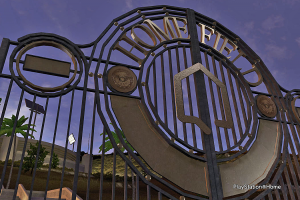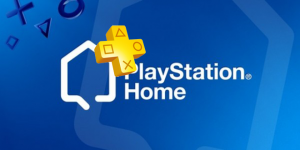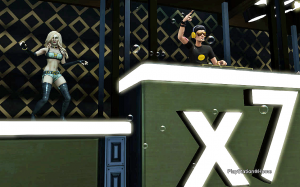The Playing Field
by SealWyf, HSM Editor
Recently we’ve been discussing large purchases in Home. How large might they become, for the right product? Is there anything on which you would be willing to spend fifty dollars?
I’m already spending that much in Home — it’s just spread out. Fifty dollars is usually about a month’s budget for me. But the only times I spent fifty dollars on one item were for tokens — the largest Lockwood Gift Machine token pack, and the largest Home Tycoon gold coin pack. These were decisions I considered carefully, but I figured I would eventually use that many tokens anyway, and the deep discount on the bulk purchase was worth the investment.
Fifty dollars was also the cost of my PlayStation Plus subscription. So here is another precedent: I’m willing to spend fifty dollars for a full year’s worth of benefit.
What if there were an annual Home subscription, a PS Home Plus, similar to the PlayStation Plus program, but limited to Home? What benefits should it offer, to make it worth the price? And, equally important — how should those benefits be structured, to minimize the resentment of those who can’t afford it?
Resentment is a real issue in a world that depends on voluntary micro-transactions. You need to encourage people buy a VIP status, while not alienating the larger number of potential customers who have not yet decided to make the investment. There is a thin line between the reasonable and the exploitative — one that may not be apparent before it’s actually crossed.
People have a finely honed sense of what is fair, and violating that sense quickly gets a developer in trouble. There’s a rule in the game-design community that you sell convenience or cosmetic improvements, but you don’t sell power. VIP players may have better equipment, but the basic playing field should remain the same. The players at the top of the leaderboard should not only be those with the deepest pockets.
I saw this principle in action a few years ago, in a Facebook game called (fluff)Friends. The premise was that you had adopted a cartoon pet, who “lived” on your profile as an image. You customized your virtual pet’s picture with graphic elements — a hat, a pair of dark glasses, fancy backgrounds, and so on.
From these simple beginnings, the game evolved into a full-fledged picture-making application, where players acquired hundreds of different graphic elements and combined them to create elaborate pictures. Some graphics were free or could be unlocked, while others were purchased for in-game currency, which could be purchased for real money. Then a paid subscription system was introduced, and special graphics were given to subscribers.
This was annoying, but not really obnoxious. The subscribers-only graphics were not all that different from what was already available, and there were plenty of other graphics we could use. What broke the loyalty of the fans was when the basic rules were changed. Subscribers could use twice as many graphic elements in their pictures — the equivalent of doubling the private space furniture limit for hypothetical Home subscribers. This meant that only subscribers had a reasonable chance of winning the frequent picture competitions or daily best-picture votes. And these competitions were the heart of the game.
That was the point where many users left. I was among them. The game was simply not fun any more. I sent all my graphics to a friend, and deleted my account. But, painful as the experience was, it was also instructive, and it gave me a framework of moral principles for monetization — what is fair to offer a VIP subscriber class in a free-to-play game with optional micro-transactions, and what just feels abusive.
So what could Home offer a subscriber, without creating an unfairly privileged VIP class? The obvious desiderata — larger friend lists, club totals and furniture allowances — are dictated by the workings of the PSN and the core client of Home. If these limits could be raised, we should all receive that benefit. And, indeed, when the private space furniture limits changed from 50 to 100, we all benefited. We also all benefited when memory mapping was changed to let active items become smaller. These were not perks that Sony was withholding to get more money. Nor should they be. They are part of the basic playing field of Home.
Discounts are an obvious perk, and one that PS Plus subscriptions provide. Discounted items for subscribers are fair, because non-subscribers can get the same things by paying full price. If the total amount of the discounts is more than the total cost of the subscription, buying the subscription becomes a sensible choice. A PS Home Plus subscription should definitely offer discounts, even if they are only on older items. We see the same strategy in x7, where discounted bundles of older items provide one reason to patronize the club.
But there are other, less-obvious privileges, ones that we know are physically possible in Home, but are not yet implemented. These might be appropriate for a subscriber package, especially if the same perks could be purchased for a one-time fee by other users.
One privilege that HSM team writer Femaelstrom mentioned in a recent article is the ability to change your user name. This has already been implemented in Japan, so we know that it is possible. A name change could offered for a one-time payment, but it could also be one of the benefits of an annual PS Home Plus subscription.
This example points out one of the ways to make subscribers’ privileges fair: offer the same privileges to non-subscribers for one-time payments. If the prices are correctly balanced, many people will see the subscription as worth some extra money up front, to avoid a larger total sum in one-time payments.
Another benefit of a Home subscription could be private instances of public spaces.
Imagine taking over an amusement park with your friends. How cool would that be? Incredibly cool — I know this from experience. I grew up in Southern California, and my father’s employer rented Disneyland one night each year for their employees’ families. There were no crowds and no lines. There was also the pleasure of staying up way past my bedtime, the heady feeling of privilege, and awesome bragging rights afterwards. We took over Disneyland last night! You should have seen it!
We have a similar thing here in Home, though it is not approved by the authorities. There are ways to generate a private instance of a public space, where you and your friends can hold a private party. This is extremely useful for a large group like the Homelings, which can max out a public space without half trying. It’s also an excellent way to avoid trolls, or to set up a tournament for a public-space game, such as Sodium 2, Cutthroats, or even Bowling.
If a PS Home Plus subscription let us create private instances of public spaces on demand, I would not hesitate to spend fifty dollars on it. To keep the playing field level, private instances could also be offered on a single-payment basis: for instance, one private instance for 24 hours might cost five dollars. This would give frequent party-organizers the incentive to pay for a subscription.
Another benefit that could be offered is to let subscribers have private copies of the current “open house” spaces, which would last as long as the same spaces are available to the public. In this case, a single-payment option would not be needed, since the open houses are available to all Home users. What the subscription would be buying is convenience — a way to inspect a new apartment without the annoyance of sharing it with strangers. People who had “borrowed” a private space during the open house might be more likely to purchase it, once their free trial had ended.
Private space previews suggest the idea of previews of all new content. We already have previews of upcoming content in the x7 exclusive-access club. What if PS Home Plus subscribers had access to new content a week before that? New content two full weeks before the publication date — that perk alone would probably sell a lot of subscriptions. But it’s still within the rules of fairness, because the same content will be available to everyone, if they just wait for it. The subscription sells convenience, and a certain air of exclusivity. But the playing field — the total inventory of goods available in Home — remains the same.
Subscriptions are a good way for a business to develop a predictable cash flow. They encourage the formation of a loyal customer base. And the perks they give make subscription-users feel special. Rightly or wrongly, feeling special and superior drives a lot of our behavior in Home.
But feeling put-upon and victimized is also a common Home emotion. Any creation of a VIP class will have to be carefully planned, to avoid alienating the non-VIP users. However, I think it’s possible, and even desirable, as long as the planners keep in mind the basic principle: sell convenience and cosmetic improvements, but don’t sell power. Provide alternate ways to acquire the same perks for non-subscribers. And never alter the playing field.







I’m sorry Seal, I haven’t read the whole of your article -- yet. It’s just, there’s a glaringly obvious thing screaming at me while reading the article; Home does not need an extra sub to Plus, it should already be a massive part of it. Plus has ( and probably still is) struggling more than it should. One of the reasons for this is that the “hard core” have already bought and finished the free games they give away with it, a serious lack of incentive there. Seems to me Plus is aimed more at the casual gamers, which is why I think Home should be a large part of it.
A lot of the people I meet exclusively inside Home, dont really play that many games. Makes perfect sense that value packs, reductions on estates or ( dare I say it) even free spaces or clothing in Home as a member of Plus would really push its sales. Here’s an example; about a month ago SCEE gave away 12 FREE personal spaces to Home users who have Plus. The forums went mad. But so did the 90-day subscription rate that month. And that’s what I’m saying; get regular Home users into Plus with extras and the rest for having a sub, and I’ll guarantee they become regular subscribers.
Who knows, they might even become gamers too! ; )
A funny tidbit along those lines: we’ve also observed that there are Home users for whom their PS3 consoles are used almost exclusively for Home — that these are people who do not avail themselves of other gaming experiences or PlayStation digital platforms. Their PlayStations are, to all intents and purposes, HomeStations — which is how we arrive at the inspiration for the name of this publication.
I totally agree, Krazy. Home benefits should be part of a PSN Plus subscription. I maintain mine mostly for the increased chance of getting into betas. And I think having Home perks as part of a PSN Plus membership would encourage a lot of people to take a look at Home so they can collect their free benefits. That could be a second article.
And yes, Norse, my PlayStation is a Home-Folding-Bejeweled3-Station at present.
I hope that Home never becomes a paid subscription in and of itself, but I agree with the concept of not making people feel alienated because they can’t afford things in it. I think your ideas hold a lot of merit Seal, and Krazy is right, plus should cover those people who rarely game outside of Home as well. Perhaps there could be 2 different types of plus subscriptions? One for Home exclusively and one for gaming? I don’t know, but either way it is an interesting concept.
Excellent article, Sealwyf. Thank you.
I confess I miss (fluff)Friends, and would probably still be playing it — mostly for the fun of creating those pictures, and participating in the community that had coalesced around the game — if the company hadn’t shafted it.
As for the community that built up around it … you already know, although probably most of your readers don’t, about a (fluff)Friend player named Meetu Asrani. She lived in India, a cheerful young woman, by all accounts, and very popular. Her favourite colour was purple; her (fluff)Friend was a flying giraffe named Giggles. And then, one terrible, terrible night in November 2008, Meetu went out to eat. At the Leopold Cafe in her native city, Mumbai …
As news spread of her death, her friends mourned. Even for those who had not known her, she became the symbol of that tragedy and personalized it — someone from our community, had died that night. Been murdered in cold blood. The game designers issued a purple flower decoration in her honour. A special Facebook dedication page was set up. And, to this day, people still post there, still think of and remember her, still are sad to have lost a friend they never met. And they’re posting the (fluff)Friend pictures they had made and managed to save, pictures in her honour, with purple flowers and the little flying giraffe.
That is the sort of community that had been created. That is what the game designers had destroyed. It wasn’t just a “Durn, that was a fun game, I wish they hadn’t yanked it!” sort of thing. And that is why so many were so angry — and why it’s a lesson well worth learning by creators of virtual communities.
Whatever is put in as a paid add on, will create a VIP class otherwise there wont be enough benefits to buy a paid subscription. Below is a list of actual subscribed users benefits from another social application. The cost is 9.99 a month 25 dollars for 3 months or 75 dollars a year. But there is a lot of features there that application, many we cant get on home. I suppose one feature id like to see is the ability to give another user access to my personal spaces while im not on line.
No third-party ads
A free special VIP badge
A free Name Change token after 3 months of continuous membership
VIP only avatar actions
Block unwanted avatar actions
Additional bonus credits for the first 12 months of your VIP subscription
Free 5,000 credits a month, and earn monthly bonus credits by staying a VIP
A free gift each month
5% savings off everything in the virtual goods catalog
Keep your closet organized
Prioritized Customer Support
Create up to 10 public rooms
Create up to 10 groups
Set your own custom room as default for Dress Up and Shopping
Whisper privately in your chats
Sneak Peek into the best new features